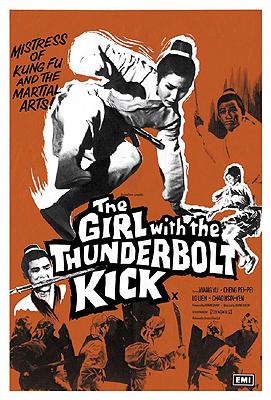 The Girl with the Thunderbolt Kick / Golden Swallow / Jin Yan Zi (1968) *½
The Girl with the Thunderbolt Kick / Golden Swallow / Jin Yan Zi (1968) *½
I got pretty excited when I learned that there was a sequel to Come Drink with Me, and I got more excited still when I learned that it had been directed not by King Hu, who helmed the original film, but by 70’s Shaw Brothers kung fu maestro Chang Cheh. Come Drink with Me’s main weakness was its uninspired fight sequences, but that’s one complaint that I’ve rarely had occasion to level against Chang. Furthermore, the sequel’s Anglo-American title, The Girl with the Thunderbolt Kick, could be taken as a promise that Chang had found somebody to teach returning star Cheng Pei-Pei some new moves. Then there was the replacement of Cheng’s former leading man, Yueh Hua, with both Lo Lieh and Jimmy Wang Yu. Both of those guys greatly impressed me in films they made during the following decade, so I had to regard their presence in The Girl with the Thunderbolt Kick as a favorable omen. All of which is basically a roundabout way of asking, what the fuck went wrong here, anyway?
Martial World heroine Xie Ru-Yan (the aforementioned Cheng Pei-Pei)— known to friends and enemies alike as Golden Swallow— has gotten herself into trouble again. A too-artful-by-half cinematographic affectation makes it next to impossible to say exactly how, but she’s getting a hard time of it from a mob of unidentified foes, one of whom scores a lucky hit on her with one of her own envenomed darts. But although we can just barely see any of this, either (Damnit, Cheh! Will you take those stupid masks off the camera lens already?!), Xie is bailed out somehow or other by Han Tao (Lo Lieh, of The Silent Swordsman and Dirty Ho)— known to his friends and enemies as Golden Whip (although his signature weapon looks more like a baton or a truncheon to me). After the battle, Han nurses the poisoned Xie back to health at his hermitage beside a sylvan waterfall.
Once Golden Swallow is just about back to full strength, Golden Whip receives a visitor, an old friend of his called Hu Zhen, or Flying Fox (Wu Ma, from The Black Tavern and Encounter of the Spooky Kind). As you might guess from his cognomen, this guy too is a martial arts master, and the conversation among Hu, Han, and Xie quickly turns to doings in the Martial World while the latter pair were out of action managing Ru-Yan’s convalescence. All the big news seems to revolve around a mysterious kung fu master known as Silver Roc. He gets his handle from the combination of his spotless white robes and his fighting style built around flying leaps and downward thrusts with the double-edged jian broadsword. Losing to him is like succumbing to the dive of a monstrous, sliver-plumed eagle. Silver Roc has been on a rampage all across the land, murdering without pity or mercy everywhere he goes. Nevertheless, opinion in the Martial World is sharply divided on his reign of terror, for all of his principal targets have been malefactors of the first order. Were it not for his refusal to distinguish their culpability from that of the lesser criminals who do their bidding, the roving killer would surely be hailed as a hero by one and all. Zhen’s news is of particular interest to Ru-Yan, because Silver Roc’s technique as described puts her in mind of Xiao Pang, another disciple of her own sifu, whom she had loved during the days of their kung fu apprenticeship. Xiao Pang vanished years ago, and Xie never did learn what became of him.
None of our heroes realize, however, that their gathering is being observed from the ridge overlooking Han’s hermitage by none other than Silver Roc himself (Jimmy Wang Yu, from Tiger & Crane Fists and The Hammer of God). Having just annihilated a gang of highwaymen, the vigilante was seeking a moment of peace and quiet in a setting of tranquil beauty, and he happened to pick just the right spot for eavesdropping. The infinitesimal shift in Silver Roc’s perpetual scowl when he spots the trio in the valley below suggests that he is indeed Xiao Pang, and the identification is all but confirmed a moment later when he pulls one of Ru-Yan’s darts out of his pocket. These darts, you see, are an instantly recognizable trademark of hers, with gold-plated finger grips in the form of (what else?) a stylized swallow in flight. For reasons that will remain ambiguous for several massacres running, Xiao starts making a point of leaving a Golden Swallow dart at the scene every time he strikes. And inconveniently enough for Xie and her friends, his next several massacres are all directed at the same organization of evil, a wide-ranging mafia called the Golden Dragons. The leader of these miscreants, Poison Dragon Wang Xing (Yang Chi-Ching, of Heroes Shed No Tears and Vengeance!), makes the natural inference that his persecutor is the famous Golden Swallow, and the next thing Xie, Han, and Hu know, they’re fending off Golden Dragon attacks on their own home turf.
What happens next illustrates perfectly the kind of damn-fool shit that denizens of the Martial World get up to if you give them half a chance. Obviously it’s now of great importance to Golden Swallow to discover whether Silver Roc is really her long-lost sweetheart. But just as obviously, to seek out such a man deliberately would be perilous in the extreme— especially since for all Xie she knows at this point, she could have it all wrong, and Silver Roc is just some bloodthirsty hobo who doesn’t know her from Nüwa. The sensible course of action would therefore be for Xie and Han to set out together, so as to have each other’s backs in the event that hunt goes badly, right? But since these are both chivalrous heroes we’re dealing with, there’s never any chance of them doing something sensible. Instead, Xie and Han each sneak out of the hermitage in the dead of night, leaving the other a note that will never be read, explaining that they’ve gone off to uncover the secret of Silver Roc’s identity. And of course they manage to time their vanishing acts to miss each other by moments when leaving the cabin. Their paths won’t cross again until they’ve each tracked down Silver Roc without the other’s help— and more or less simultaneously, at that!
Meanwhile, Xiao Pang continues butchering Golden Dragons in job lots, leaving no one alive to refute Wang Xing’s supposition that Golden Swallow is responsible for the killings. Eventually he gets around to the Cao brothers (Ching Miao, from Heroes of the East and Princess Iron Fan, and Tang Ti, of Fairy, Ghost, Vixen and Killers Five), a pair of high-ranking operatives directly subordinate to Poison Dragon himself, and the overboss realizes that he’s got no choice but to take matters into his own hands. In a way, that’s convenient for Ru-Yan, however, because the need to counter an all-out offensive by the Golden Dragons will force Silver Roc and Golden Whip to set aside their burgeoning mutual hostility until Wang Xing and his mob are put permanently out of business. Make no mistake, though— now that Han and Xiao have recognized each other as both philosophical antagonists and romantic rivals, the only thing that will stop them from dueling one of these days is if one or both of them get killed by the Golden Dragons first.
Whether you watch this movie as Golden Swallow or as The Girl with the Thunderbolt Kick, the title promises in no uncertain terms that the focus of the story will be on Xie Ru-Yan. This is a Chang Cheh movie, though, and if I’ve learned anything about Chang since committing myself to a systematic exploration of Hong Kong martial arts cinema, it’s that the man simply had no interest in women as characters (and barely any interest in them even as sex objects!). We probably shouldn’t be surprised, then, that The Girl with the Thunderbolt Kick lavishes the lion’s share of its attention on Han Tao and Xiao Pang instead, and emphasizes their conflict regarding Ru-Yan over her own involvement in it. Nevertheless, it’s extremely frustrating, because Golden Swallow and Cheng Pei-Pei alike were such vibrant and forceful presences in Come Drink with Me. It gets worse, too. This sequel so thoroughly reinterprets the title character that she becomes unrecognizable. There’s no mention of her family ties to the provincial court, no trace of her former role as a special agent of official authority. Her fighting skills, while still formidable, no longer seem to place her just below the level at which wuxia warriors acquire magical chi powers. And it’s flatly impossible to imagine the Golden Swallow of Come Drink with Me dithering in futile indecision while rival claimants to her affections plot to kill each other over her. All that remains of the previous film’s powerful, feisty heroine is her dual-wielded short swords and the ludicrous pretense that anyone could possibly mistake her for a man just because her outfit is a little androgynous. Why make a sequel to Come Drink with Me at all if this is how you’re going to do it?
The Girl with the Thunderbolt Kick also marks one of the rare occasions when Chang Cheh has disappointed me on the action front. Obviously it would have been folly to expect anything close to the fighting in the Shaolin Temple series. Although Lau Kar Leung did contribute to the fight choreography here, this was well before he undertook his self-appointed mission to bring authentic Southern Chinese kung fu to the screen, and that sort of thing was never what wuxia was about anyway. But I don’t think it was unfair of me to hope for action on par with the frenzied knife-and-cleaver battles in Vengeance!, which required no Hung Gar master on the set to make them work. Incredibly, Chang eschews even the editing trickery that enabled King Hu to sell the lackluster fighting in Come Drink with Me. Placement and movement of the cameras during most of the fight scenes are similarly pedestrian, too, leaving The Girl with the Thunderbolt Kick in the same lame league as a B-grade Hollywood swashbuckler of the 40’s or 50’s.
Against all that, the main thing that The Girl with the Thunderbolt Kick has to recommend it is the cinematography by Pao Hsueh-Li, which is impressive indeed. Most atypically, Chang shot the film on location in Japan, so even experienced Shaw Brothers fans will find it a welcome visual relief from the ubiquitous Movietown back lot. Pao draws out every bit of natural beauty in those woods, hills, and valleys, so that the scenery itself gives us plenty to look at even when the swordplay doesn’t. I’m not sure “Yeah, but it looks like a haiku come to life” is a terribly persuasive defense for a martial arts movie that shirks its primary genre responsibilities the way this one does, but that’s the closest thing to a commendation that I can give The Girl with the Thunderbolt Kick.
Home Alphabetical Index Chronological Index Contact

